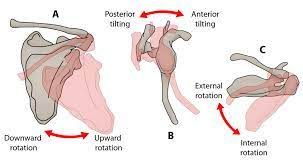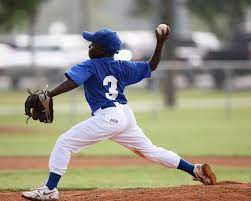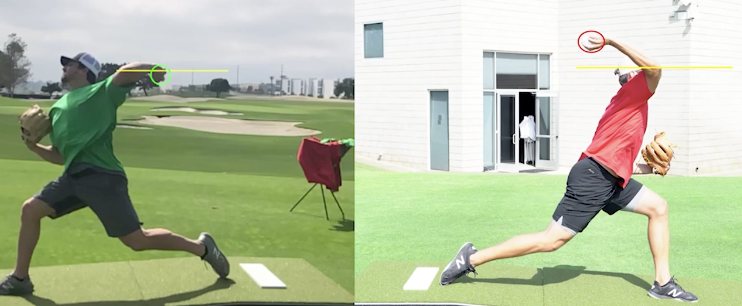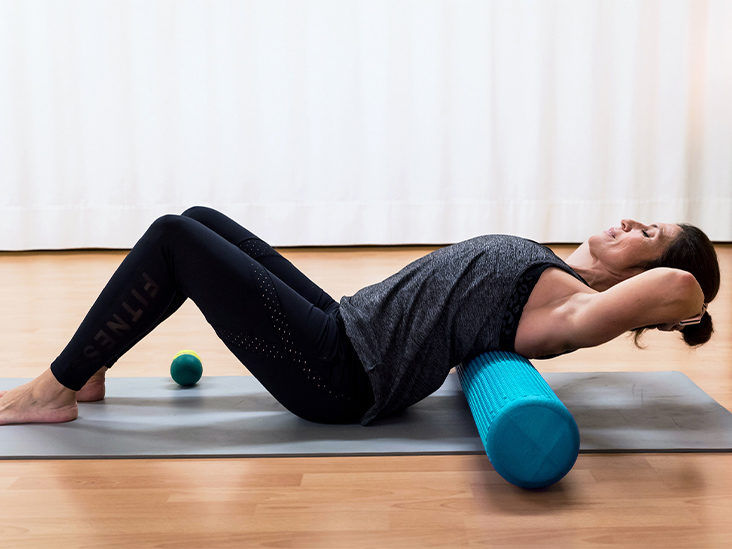Want to Increase Pitching Velocity? Improve Layback
- Eclipse Wellness

- Apr 4, 2022
- 7 min read
Updated: Jul 3, 2023
What is Layback?
Layback refers to the position of maximal shoulder external rotation in pitching. It is pictured below

It is easiest to think of layback as the farthest point behind you that your hand will go before accelerating towards the plate. It is a combination of multiple movements, but it is most associated with shoulder external rotation. There are different factors that go into shoulder external rotation, but the primary causes are joint and muscle anatomy.
Research by Reagan, et al. showed that college baseball players had an average of 10.6 degrees of greater retroversion in their throwing arm. Retroversion refers to the position that your humeral head assumes relative to your scapula in your shoulder joint. If you want to picture it, think about rotating your shoulder forward as if there was an axis straight up and down through your shoulder. That is a retroverted position. Some retroversion is normal, as the study from Reagan, et al. showed an average of 26 degrees of retroversion on the non-throwing arm. However, baseball players and especially pitchers gain significant retroversion from throwing a baseball at a young age. The reason that younger players see bony adaptations is because they still have open growth plates. These are the areas at the end of bones that grow as we get taller. They are weaker parts of the bones and thus can be deformed. Normally, bony deformation is something to be avoided, but it is necessary in this case.
If you try to throw a ball with your non-dominant shoulder, you probably notice that it is challenging. Part of the reason that it is so difficult is because you do not have the necessary retroversion. If you try to externally rotate your arm while standing, you will have significantly more motion in your throwing arm. Because you never threw with your non-dominant arm as a child, the growth plate never deformed from the repetitive force. This leads to the expression “throwing like a girl”. Traditionally, girls did not play baseball, so they never gained the necessary retroversion and the resulting throwing motion is awkward and inaccurate. This is obviously an outdated expression now that girls and women play baseball and softball with much greater frequency at a young age.
The other cause of greater layback in the shoulder joint is muscle laxity. Repetitive throwing can stretch the muscles in the front of your shoulder that resist external rotation including the pecs and subscapularis. Imagine if you only turned your neck one way at high velocities everyday. You would stretch out the muscles on the other side and gain more range of motion in that direction. This occurs with the shoulder muscles due to repetitive throwing.
A common mistake that people make is thinking that layback is solely due to the shoulder. There are other joints that contribute to full range of motion, particularly the scapula and thoracic spine. This picture of Billy Wagner shows his incredible layback, but pay attention to the angle of his spine.

The thoracic spine is typically arched forward as pictured below:

However, many pitchers will actually have an extended thoracic spine from constantly throwing overhead. The extended position allows for greater scapular mobility due to improved muscular alignment and rib position. To demonstrate this, try slumping forward and reaching up as high as possible. Now sit with an overly extended posture and reach overhead. You probably reach significantly higher while extended and feel less tension in your back and shoulder. Thoracic spine extension is crucial for excellent layback.
Good thoracic extension allows for improved scapular mobility. To familiarize yourself with the motions of the scapula, consult the graphic below courtesy of sportsinjurybulletin.com

Full layback requires upward rotation, posterior tilting, and external rotation of the scapula to give optimal clearance to the head of the humerus. If your scapula stays in the wrong position, it can limit humeral mobility. Also, your rotator cuff muscles run from your scapula to your humerus. If the scapula stays pinned back along your spine, then those muscles become overly stretched and lose their mobility. It is important to ensure adequate mobility of the thoracic spine and scapula for full, healthy layback.
What About GIRD?
GIRD refers to Glenohumeral Internal Rotation Deficit and it describes the loss of internal rotation that many pitchers experience in their throwing arm. Years ago, it was thought that GIRD led to greater injury risk. This hypothesis has been debunked as we gain a better understanding of the anatomical differences in the throwing and non-throwing shoulder. It is impossible to achieve full internal rotation in the throwing shoulder due to bony and muscular changes, nor should we be attempting to reach it.
A study by Wilk, et al. in 2011 showed that total arc of motion was more important than internal rotation range of motion in professional pitchers. Total arc is calculated by adding external and internal shoulder rotation. If the pitching shoulder had a deficit of more than 5 degrees, then the pitcher was more likely to be injured. The theory behind this lies in retroversion shifting the range of motion from even between external and internal rotation to being biased towards external rotation. An example would be external rotation of 90 degrees and internal rotation of 90 degrees in the non-throwing shoulder leads to a total arc of 180 degrees. External rotation of 120 degrees and internal rotation of 60 degrees in the throwing shoulder also results in a total arc of 180 degrees.
Another study by Wilk, et al. in 2015 showed that a loss of motion in shoulder external rotation in the throwing shoulder actually predicted injury as well. They compared the throwing shoulder to the non-throwing shoulder, and if the throwing shoulder did not have at least 5 degrees more of external rotation, then the pitcher was 4 times as likely to require shoulder surgery. Anecdotally, I rarely see pitchers with that little increase of external rotation in their throwing arm, but this does highlight the importance of layback.
Why is Layback Important for Velocity?
The study I just highlighted showed that increased layback can improve injury risk, but what about performance? Well, it can also increase velocity. A study by Matsuo, et al. showed that increased maximal shoulder external rotation correlated with higher pitching velocity. This intuitively makes sense, as greater layback allows for a longer run up when throwing the ball. More time to accelerate through the shoulder should transfer more force to the ball and result in increased velocity.

This image is an excellent example of a young pitcher who has not yet developed retroversion. He has excellent mobility of his scapula, as you can see that it is retracted significantly. However, he has minimal external rotation through the shoulder. If you are unsure about shoulder rotation, consider the assessment created by OnBase University. They describe high hand as the ball being above the elbow during maximal layback. The image below, courtesy of their website, shows the difference between good and bad layback in simple terms.

Exercises to Improve Layback
Layback can be difficult to increase as it is often a multifactorial problem. Many athletes will simply stretch their shoulders into external rotation, and this may not even be the issue. Another possible source of layback is weighted balls. A study by Reinold, et al. showed that 6 weeks of a weighted ball program increased external rotation by 4.3 degrees on average. That is a significant jump and it did result in multiple injuries to the test subjects. I believe the weighted balls can be useful for mechanics and in some cases may be appropriate for improving layback in athletes. However, they are not my first intervention, as there are typically other effective methods to utilize.
As I previously mentioned, the shoulder joint is not the only limiting factor with layback. Oftentimes, the thoracic spine can become stiff, and simple mobility exercises can improve thoracic extension and lead to greater shoulder external rotation. Using a foam roller for thoracic extension can allow for a temporary improvement in mobility that can be followed with other exercises. This image courtesy of healthline.com shows a basic movement that you can utilize.

Another thoracic spine exercise involves mobilizing the spine and stretching the latissimus dorsi muscles. It can be viewed here being demonstrated by Eric Cressey.

Regarding scapular mobility, I prefer the external cue of rolling a foam roller up and down the wall. This forces you to rotate your scapula up and around to maintain contact with the roller and keep it on the wall. The exercise is pictured below courtesy of researchgate.net

In regards to stretching the shoulder muscles themselves, any sort of stretch for the pecs such as the one shown below can be beneficial courtesy of precisionmovement.coach. The key with this exercise is to keep the chest pushing forward and not to slump down, as that can stress the shoulder joint and not adequately stretch the muscles.

Sometimes limitations in layback can come from the rotator cuff muscles on the back of your shoulder including the infraspinatus and teres minor. Mobilizing these muscles with a lacrosse ball on the wall as pictured below courtesy of theclimbingdoctor.com can provide improvement.

Finally, it is important to understand that passive range of motion is necessary for layback, but active range of motion can provide improved control and decrease injury risk. You want to train your muscles in external rotation to provide stability which can ultimately lead to increased mobility. Simple liftoffs like the one picture below and demonstrated in this video can improve active mobility into layback.

Those are a few of the exercises that I utilize for my clients who struggle with layback. Unfortunately, there can be many reasons why you do not achieve adequate mobility on the mound, so the best strategy is to be assessed by a healthcare professional who specializes in overhead athletes.
As always, if you are suffering from pain, nerve symptoms (numbness, tingling, or weakness), or anything else significant, please see a healthcare provider. This blog is meant to be educational and is not a substitute for medical advice.
Hopefully you learned something about the importance of layback in baseball pitchers. It is necessary for health and performance reasons, but often overlooked by healthcare providers and coaches. If you found this blog helpful, please share it with someone. We hope to continue to grow and help people better understand how our bodies move and work. If you want to subscribe so that you don’t miss any other posts, click the sign in button on the top right of this page. Once you have created an account, click the drop-down menu in the top right next to your name and go to your settings page. Click the subscribe button next to “Blog Subscription” and you won’t miss any future posts! If you are in the Sterling, Virginia area and would like to work with me or you have any questions, please email me at danny@eclipsewellnessnova.com or follow me on Instagram or Twitter @drdannydpt.




Comments